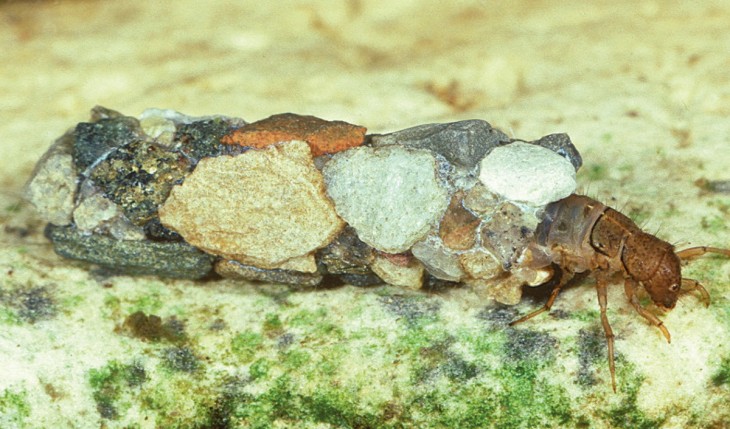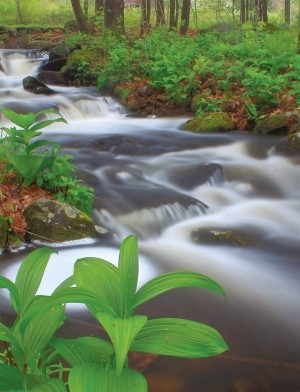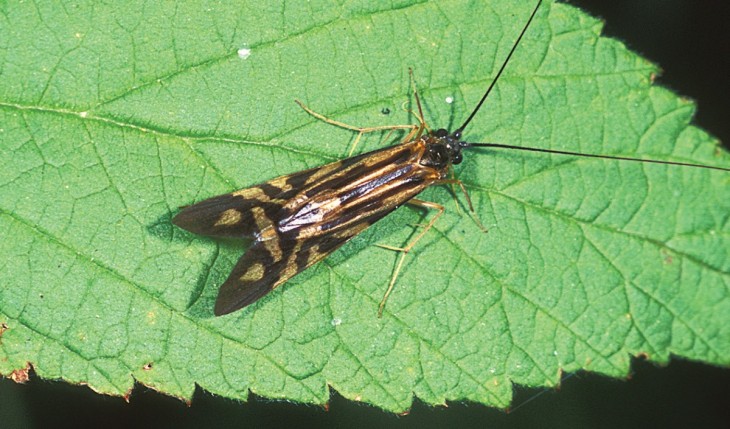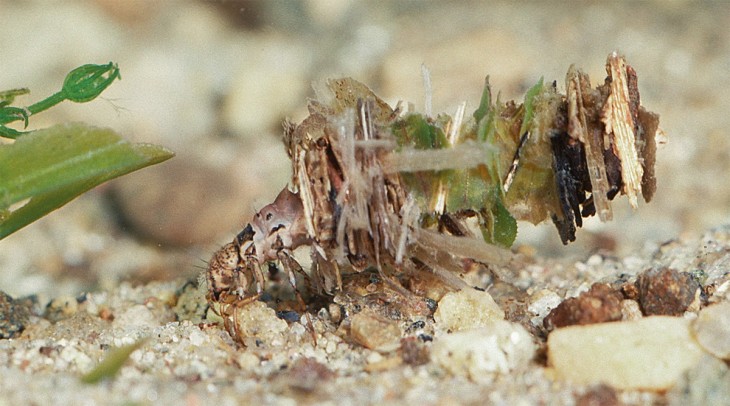If you live near water, then beginning in late spring, you likely will have some fascinating insects flocking to your porch. Caddisflies might pass for gray, brown, or black moths, but they are worth a closer look (1). To identify them, look first for the long, slim antennae that fly-fishers love to imitate. Often, the antennae are longer than the insect’s body. Caddisflies lack the coiled mouthparts of moths and butterflies, and if you are looking very closely, you might be able to spot four hairy wings. The wings sit like a ridge tent, peaking near the back end.
While caddisflies are visually striking on your porch, most of their life cycle happens beneath the water’s surface. Glenn Wiggins of the Royal Ontario Museum called them “under-water architects.” In fact, all of a caddisfly’s architectural feats happen in ponds, lakes, and rivers, where freshly hatched larvae are ready to spin silk for various purposes. I once watched microscopic Apatania blacki larvae emerge from their eggs and immediately assemble fine sand grains into tiny, silk-lined protective cases. Many caddisfly larvae make portable tubular cases; others attach nets to streambeds to filter food from the water. Some use silk simply to avoid being washed downstream.


Caddisfly cases, constructed using twigs, leaves, snail shells, or sand grains and pebbles, can resemble sleeping bags. Each is unique – one Neophylax larva I collected from the LaPlatte River combined two other caddisfly cases to form its mobile home. Although a case’s style is species-specific, the differences are often subtle, so some microscope work may be needed to identify them.
The life cycle of these insects is equally amazing. As a caddisfly larva grows during winter, it undergoes five molts, shedding the entire exoskeleton as a new one forms. The final larval molt coincides with the metamorphosis from larva to pupa, setting the stage for drastic tissue rearrangement and the mass migration of cells to produce hairy wings and lithe antennae. Stout mandibles grow solely to liberate the adult caddisfly from the silk-lined case, which would otherwise become a tomb.
Caddisflies link submerged and dry-land habitats. Leaves that fall into lakes and streams in October are consumed by the caddisfly larva, such as this Pycnopsyche larva (2). When the insects cycle back to the terrestrial realm as adults in spring (3), they are in turn eaten by spiders, bats, and birds.
The adults, familiar to boaters and anglers, live from days to weeks – long enough to mate and lay a few hundred eggs in submerged gelatinous balls. The adults may sip a little nectar on land, but not much. Caddisflies actually lose weight as adults, and one study showed that males lose seven percent of their body mass just during copulation.
Many caddisflies never get ashore thanks to the phalanx of hungry fish just waiting for “the hatch.” Fish often focus on the most common prey until it dwindles, then they switch to whatever species emerges next. Wise anglers “match the hatch” by presenting flies that mimic the particular caddisfly, mayfly, or other insect that is hatching in their favorite stream when they happen to be fishing. It’s unlikely that a great brown autumn sedge fly will tempt a brook trout in May!
Some caddisflies require clean, cold water, and ecologists use them to help evaluate water quality in streams. But simply finding lots of caddisflies is not enough to suggest clean stream water. In fact, my students and I have found caddisflies in all of the 80 or so Vermont streams we have sampled – including those draining parking lots, farms, golf courses, and suburban neighborhoods. Filtering caddisflies in the family Hydropsychidae, for example, thrive in the nastiest of streams. But detecting several species of caddisflies, along with stoneflies and mayflies, certainly indicates a healthy stream that’s worthy of some fishing time.
If fishing is your sport, it might be worth taking some time the night before to hang a white bed sheet and a black light next to your stream. If many caddisfly species show up, it’s a very good sign. And if you happen to have the right fly in your tackle box to match the most prevalent caddisfly, then your time as an impromptu entomologist will have been very well spent indeed.





